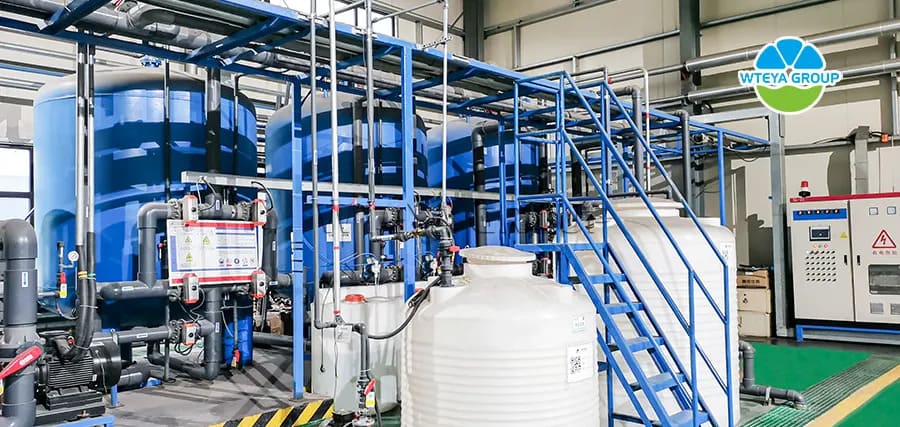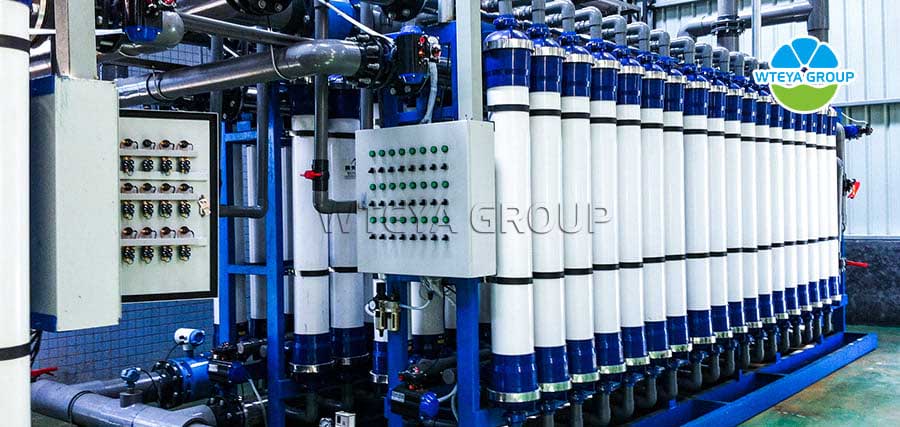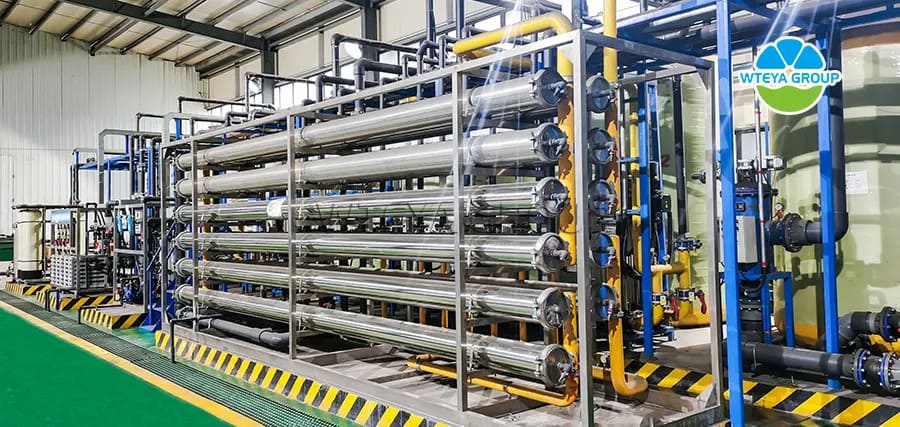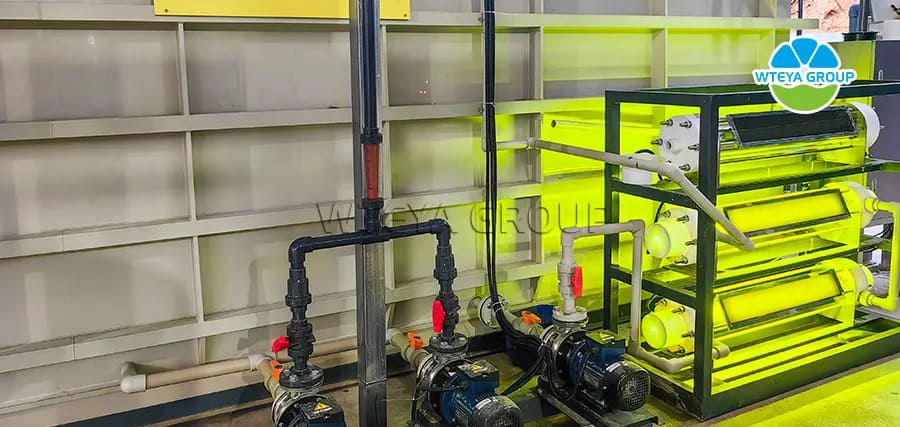Electronic Semiconductor Industrial Solutions
1. Multiple media/activated carbon filtration systems:
In the manufacturing industry
Multimedia filters are typically used in the initial stage of water treatment, effectively removing suspended solids, colloids, particles, and various impurities from water through a combination of multiple media, providing clean water for subsequent treatment. This step is crucial for protecting subsequent processing equipment and improving overall processing efficiency.
Activated carbon filters are mainly used to remove organic matter, odors, pigments, and other impurities from water. Activated carbon has strong absorption capacity, which can absorb and remove pollutants from water, thereby improving the purity of water. This step is crucial for ensuring the quality and stability of ultrapure water.
By combining multimedia filters and activated carbon filters, you can effectively remove most impurities from water for further advanced treatment (such as reverse osmosis, ion exchange, etc.), providing good basic quality. This helps to ensure the quality and stability of ultrapure water required in the production process of the electronic semiconductor industry, in order to improve product performance and reliability.
Technical Principles
The principle of multimedia filtering technology is mainly to use one or more filtering media for deep filtration to remove liquid impurities in water. When the raw water passes through the filter material from top to bottom, large particles are removed at the top layer, while small particles are removed deeper in the filter medium. This mainly depends on the absorption and mechanical resistance of the filter material layer, as well as the compactness of the sand particle arrangement, making the particles in the water more likely to collide with the sand particles and be blocked. After this treatment, the liquid on the water can be kept at a lower level to ensure the clarity of the water quality.
The technical principle of activated carbon filters is mainly based on the absorption of activated carbon. Activated carbon has a huge surface area and complex pore structure, which gives it strong absorption capacity. When water passes through an activated carbon filter, organic matter, odor, color, and other pollutants in the water are absorbed by the surface of the activated carbon and effectively removed. In addition, activated carbon can also remove chlorine from water to ensure the normal operation of subsequent treatment equipment.
What achievements can we achieve?
Firstly, multimedia filters are used as preprocessing devices, and their design of multiple combination media enables them to effectively remove adhesives, particles, and large impurities from water. This is crucial for protecting subsequent water treatment equipment and processes to ensure the stable operation of the entire water treatment system. Through this step, initial clean water can be provided for the electronic semiconductor industry, reducing the potential impact of impurities on the production process.
Secondly, filter activated carbon utilizes its strong absorption capacity to further remove impurities such as organic matter, odor, and pigment from water. If these impurities are not removed, they may have adverse effects on the quality and performance of electronic semiconductor products. The application of activated carbon filtration can greatly improve the purity of water and meet the strict requirements of the high-quality electronic semiconductor industry.
2. Ultrafiltration system:
And in production
Firstly, during the cleaning process, the membrane can effectively remove particles and ions from water, serving as a high-quality ultra pure water treatment process. This type of ultrapure water is used to clean semiconductor equipment and devices, ensuring that the surface of the product is clean and avoiding the impact of pollutants on product performance and reliability.
Secondly, ultrafiltration technology is commonly used to manufacture liquids. In the semiconductor manufacturing process, it is necessary to use technical fluids such as acids, potassium, organic solvents, etc. Ultrafiltration membranes can filter and clean liquids, remove impurities and particles, and ensure that the quality and purity of the liquid meet production requirements.
In addition, ultrasonic filtration technology also plays an important role in the cooling water circulation of equipment. Semiconductor manufacturing equipment generates a large amount of heat during operation and requires cooling water to cool the heat. Ultrafiltration membrane can remove particles and ions from cooling water, prevent impurities from damaging equipment, ensure normal operation of equipment, and ensure product stability.
Technical Principles
The technical principle of ultrasonic filters is mainly based on pressure controlled membrane separation processes. The core is to use a special diameter semi permeable membrane called an ultrafiltration membrane to prevent relatively high colloid, particle, and molecular weights in water, while water and small solvent particles can penetrate the membrane.
The ultrafiltration membrane has an elongation of 20 to 1000A degrees, a filtration distance of 0.002 PM to 0.2 PM, and can effectively inhibit particles with a diameter greater than 0.02 PM, such as proteins, pectin, fats, and bacteria. Different materials and structures of filter membranes have different effects and applications, so you need to choose a filter membrane that is suitable for specific application needs. At the same time, working conditions such as pressure, speed, and temperature can also affect the ultrafiltration effect and require optimized control.
What kind of results can we achieve
Firstly, the ultrasonic filtration system provides purified water. In the manufacturing process of electronic semiconductors, there is a high demand for water quality, and any small impurities can seriously affect the quality and performance of the product. The ultrafiltration system adopts high efficiency filtration capability, which can effectively remove particles, gel, bacteria and other impurities in the water, ensure the purity of water in the process, and meet the high quality requirements in the production process of electronic semiconductors.
Secondly, ultrafiltration systems can protect production equipment. Due to the fact that ultrafiltration systems can provide pure water for the process, it helps to reduce quality issues caused by corrosion and dirt in manufacturing equipment, thereby extending the service life of the equipment and reducing maintenance costs.
In addition, filtration systems can also help improve production efficiency. By ensuring the quality and stability of water during the process, ultrafiltration systems can reduce product quality caused by production interruptions and quality issues, ensuring the continuity and stability of the production process and improving production efficiency.
Finally, filtration systems also contribute to creating the environment and sustainable development. By effectively removing pollutants from water, ultrafiltration systems can reduce the difficulty and cost of wastewater treatment, and minimize their impact on the environment. Meanwhile, the application of ultrafiltration systems also helps to drive the electronic semiconductor industry towards more environmentally friendly and sustainable manufacturing methods.
3. Reverse osmosis membrane system:
In the manufacturing industry
Reverse osmosis membranes in the semiconductor industry are mainly used in the production process of ultrapure water. In the manufacturing process of electronic semiconductors, ultrapure water is widely used to clean important components such as silicon chips and chips, effectively removing surface particles and organic matter, and reducing product shortage rates. Reverse osmosis membranes can provide stable and low tension deionized water, meeting the high quality requirements of the semiconductor industry.
In addition, reverse osmosis membrane technology can also provide high-quality clean water to ensure the reliability and stability of components. By utilizing the characteristics of reverse osmosis membranes, you can precisely control water quality and meet the strict requirements for ultra pure water in electronic semiconductor manufacturing processes.
Technical Principles
Reverse osmosis membrane is usually a synthetic semi permeable membrane with a very small size, which can effectively prevent impurities such as salt, organic matter, and heavy metal ions from decomposing in water, while allowing water molecules to pass through. If a pressure greater than the osmotic pressure is applied on one side of the thick solution, the solvent will flow in the opposite direction to the original osmotic direction and begin to flow from the thick solution to the dilute solution side. This process is called reverse osmosis. At this point, the solvent under pressure passes through the reverse osmosis membrane, and the solution is blocked by the membrane to achieve separation and purity.
What achievements can we achieve?
Firstly, reverse osmosis membranes can effectively remove impurities such as bacteria, organic matter, and metals from water, ensuring the quality and stability of ultrapure water. This high-purity water is essential in the manufacturing process of electronic semiconductors, used to clean important components such as silicon and chips, effectively remove surface particles and organic matter, reduce product defect rates, and thereby improve product quality and performance.
Secondly, the use of reverse osmosis membrane technology has slowed down the changes in water quality caused by water quality fluctuations, thereby facilitating the stability of water quality in production. This has a positive effect on the quality stability of ultrapure water products, helping to ensure the quality production of semiconductor products.
In summary, the application of reverse osmosis membranes in the electronic semiconductor industry can achieve the production efficiency of ultrapure water, ensure the stability and reliability of product quality, and help reduce production costs and environmental pollution.
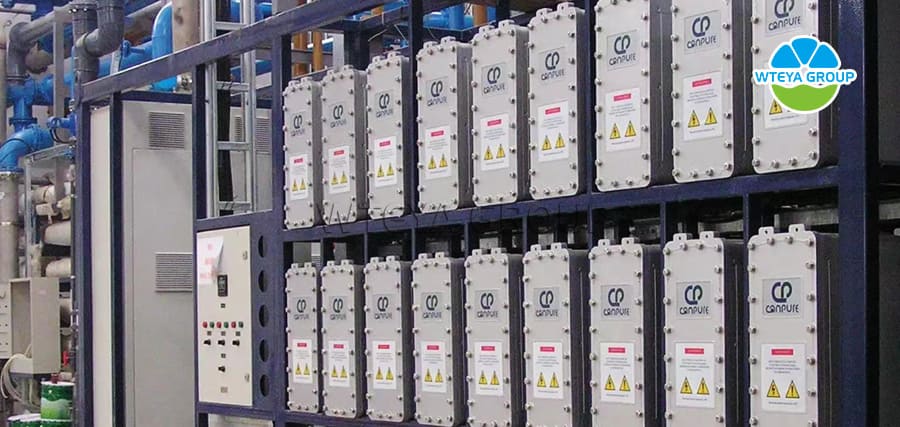
4. EDI system:
And in production
EDI systems or electronic deionization systems are widely used in the semiconductor industry. It is mainly used to manufacture ultrapure water.
In the semiconductor manufacturing process, ultrapure water is used for many key processes, such as the cleaning of key components such as silicon chips and chips, as well as the preparation foundation of other technological fluids. The EDI system can use ion exchange membrane technology and electron migration technology to remove ions and other impurities from water, producing high-purity ultrapure water.
Specifically, EDI systems can remove ions from water, such as sodium, calcium, magnesium, chloride, sulfate, and anions, resulting in very low water conductivity and meeting the high water quality requirements in semiconductor manufacturing processes. In addition, due to its effective ion removal ability, EDI systems can also reduce the regeneration frequency and chemical consumption required in traditional ion exchange processes, reducing operating costs and environmental impacts.
Technical Principles
The technical principles of EDI systems are mainly based on ion exchange membrane technology and electron migration technology.
Under the influence of DC field, dielectric ions in the partition of EDI system move in the direction. Ion exchange membranes can selectively pass through ions, allowing some ions to pass through and preventing others from passing through to clean water quality. In this process, the ion exchange resin is continuously regenerated by electricity, so there is no need for acid and potassium regeneration.
Specifically, the EDI module clamps the EDI unit filled with ion exchange resin between ion/negative exchange membranes into the EDI unit, which is separated by a mesh panel to form a water and fresh water chamber. After placing the anode/cathode at both ends of the part, direct current will push the positive and negative ions flowing through the corresponding ion exchange membrane into the water storage chamber to eliminate these ions in the fresh water chamber. The water in the thickened water chamber can take ions away from the system and produce thickened water.
What kind of results can we achieve
The EDI system can effectively generate ultrapure water. In the semiconductor manufacturing process, ultrapure water is an important manufacturing element for cleaning core components such as silicon chips and chips, and is also the foundation for preparing other technological fluids. The EDI system adopts ion removal efficiency, which can remove ions, organic matter, and impurities from water, ensuring the quality and stability of ultrapure water and meeting the high requirements of semiconductor production quality.
Moreover, the controlled EDI system is easy to scale up and down, does not require regeneration, and has advantages such as stable water quality. Its water supply meets the requirements of the situation and can ensure that the water quality continues to produce a water resistance rate of ≥ 15M Omega.
5. Bed polishing system:
And in production
The bed mixture polishing in the semiconductor industry is mainly used in the production process of ultrapure water.
Chip cleaning: In the process of chip manufacturing, a series of impurities are generated after chemical/physical, corrosion, baking, and other processes. To remove these impurities and ensure the effectiveness of the chip, it is necessary to clean it with ultrapure water.
Semiconductor material production: Ultra pure water can remove impurities on the surface of semiconductor materials, ensure the purity requirements of semiconductor materials, and effectively improve the performance and reliability of semiconductor chips.
In these technical steps, ultrapure water is used to clean semiconductor equipment and equipment, ensuring the cleanliness of product surfaces and avoiding the impact of pollutants on product performance and reliability. The polishing bed mixing system can effectively remove ions and organic matter from water, ensuring that the water quality meets high standards in the semiconductor industry.
Technical Principles
The technical principle of polishing mixer is mainly based on the principle of ion exchange. This type of plastic is a polymer compound composed of special ion exchange groups that can exhibit ion exchange function in water.
In semiconductor industry applications, polishing mixed beds are mainly used to prepare ultrapure water. When raw water containing impurity ions passes through plastic, the ion exchange groups in the plastic exchange with these impurity ions, absorbing them into the plastic and releasing ions that are harmless to the process. Through this method, impurity ions in the raw water are effectively removed through ion exchange of the resin, in order to obtain high-purity water.
What kind of results can we achieve
Firstly, it ensures the quality of ultrapure water. Ultra pure water is very important in the manufacturing process of electronic semiconductors. Mixed polishing can effectively remove ionized water, organic matter, and other impurities, ensuring the quality and stability of ultrapure water, and meeting the production quality of high-quality electronic semiconductors.
Polishing the mixed bed also helps to improve production efficiency. Due to its high ion exchange efficiency and stable performance, it can reduce equipment production and maintenance interruptions caused by water quality issues, ensuring the continuity and stability of the production process.








